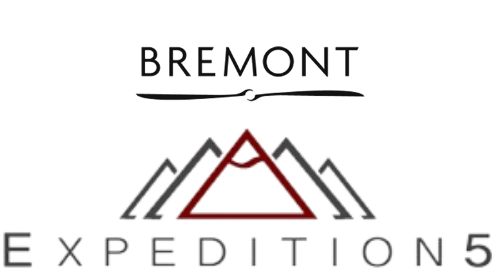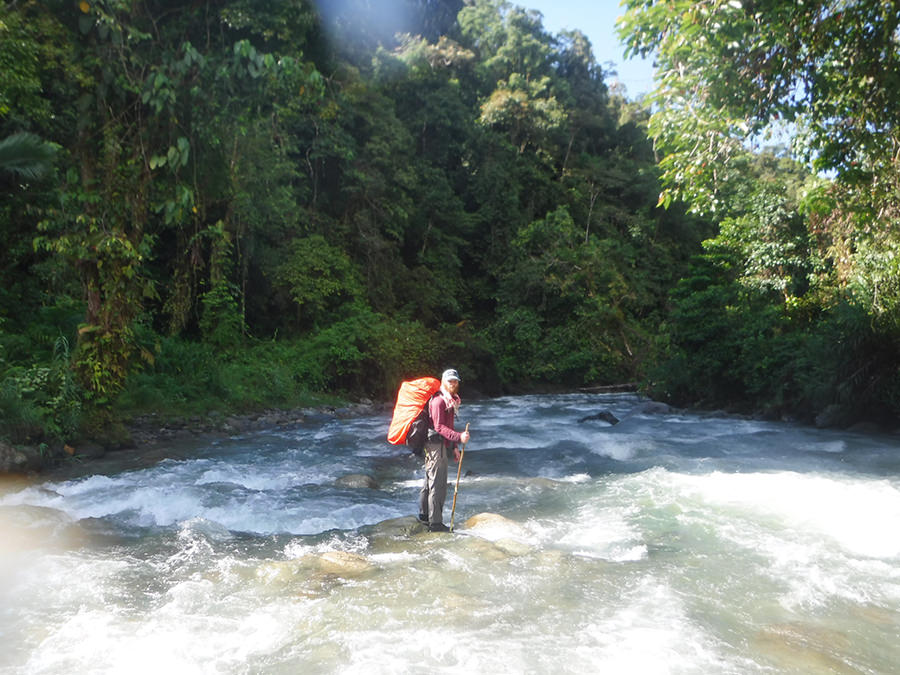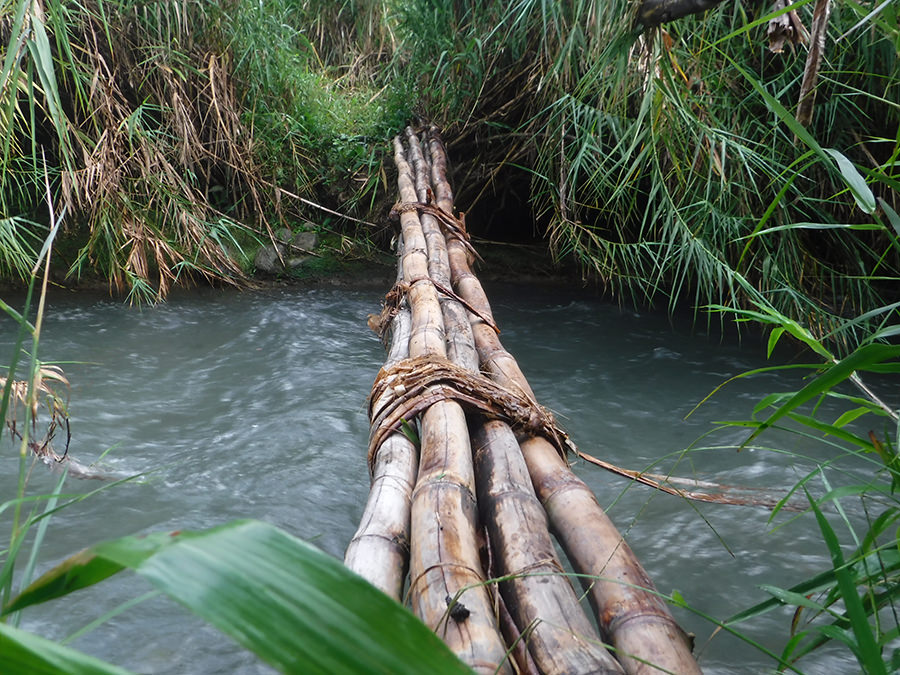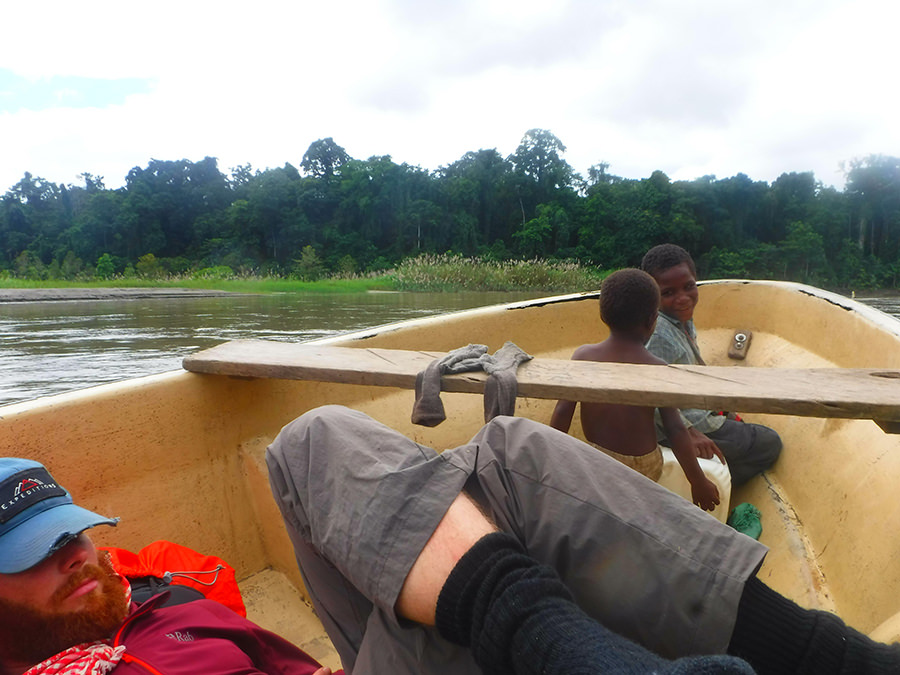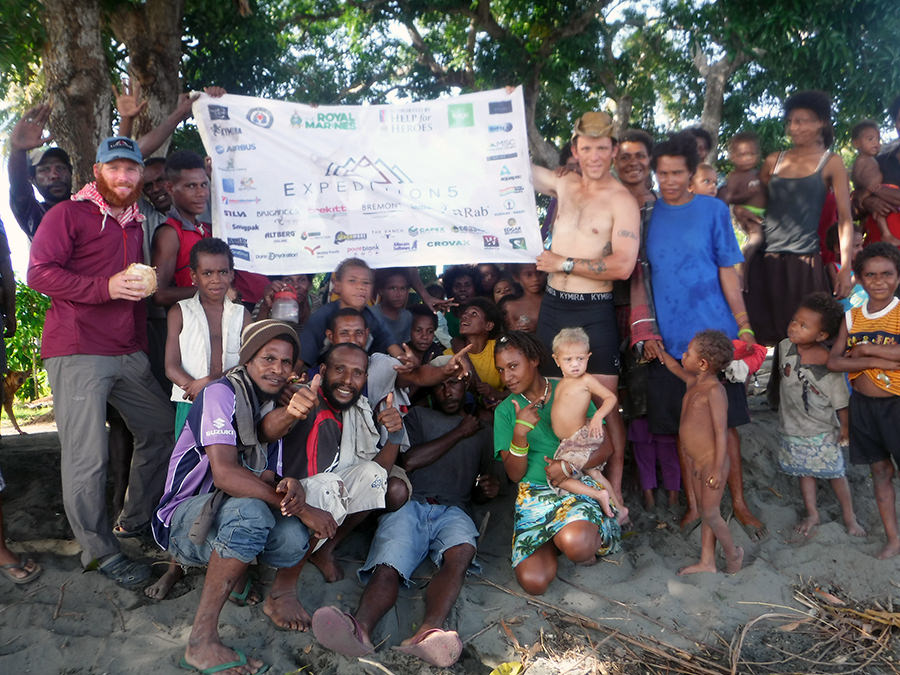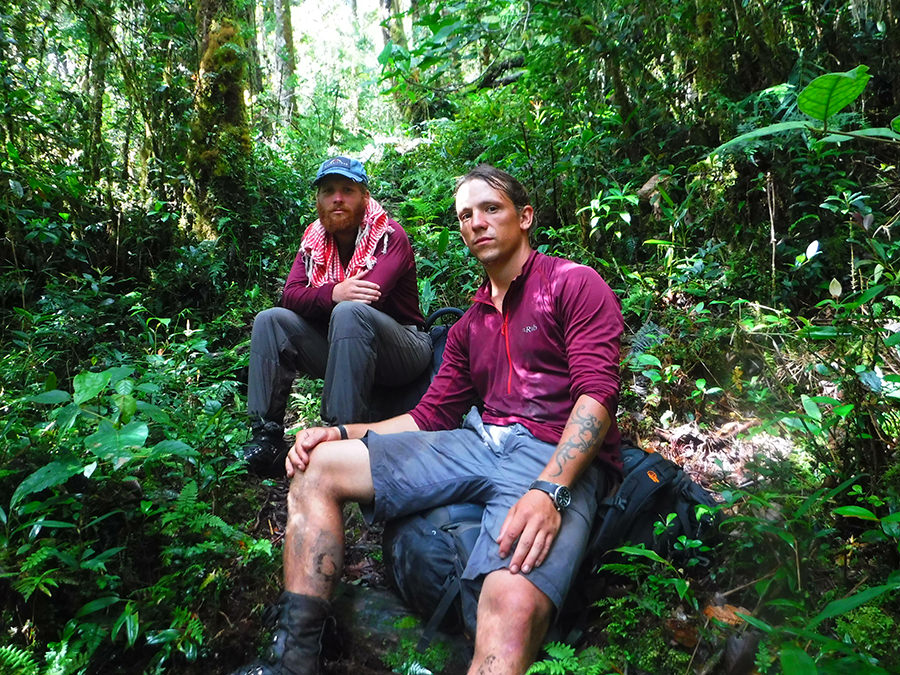Chiming pierced the air, shaking us both from our frail slumber. Daybreak was upon us and the occupants of Winima all stirring to find out what the commotion was about. Like a shot Hennis (our guide) slipped from the grass roofed wooden house we slept in and made his way towards the high-pitched hubbub. In silence Lou and I started to go through our well-rehearsed morning routine;
• Hammocks down and packed,
• “Clean” clothes off,
• Still damp (from previous days’ river wash) Yomping clothes on,
• Water check,
• Take anti-malarial,
• Brush teeth,
• Start fire,
• Boil water,
• Check out the condition of the villages bush toilet (wooden shack complete with a narrow hole in the floor where skilful aiming and quads of steel are essential) as water boils
• Drink “hot wet” (hot beverage) of choice,
• Eat banana/sweet potato variant
• “Drip” (complain) about above meal choice
• Look at map/GPS and ponder wistfully about what horrendous activities lay in store for the day ahead…
As we sat chatting, our guide reappeared, the early morning wakeup call he informed us, was to announce one of the villages older residents had passed away during the night. The villagers would now set to implementing their tribe’s unique traditions involving the dead. As we walked out of Winima with Hennis, a giant morose crowd had already gathered in the centre of the settlement, sad eyed and downcast they all still waved us off cheerily as we left, wishing us luck in the final chapter of our journey.
The previous day Hennis had informed us we would be heading for a settlement called Yanina, where the previously mentioned Bulldog track would begin. To get there we had to make our way through the surrounding rainforests up several mountains to nearly 3000 metres to a settlement called Kudjeru. From here we would make our way up and over a mountain range known as the Bulolo Watut Divide and descend into The Gulf Province where we would reach The Bulldog track. We were told it would take 2 hours to reach Kudjeru, and another 4 to reach Yanina.
After 5 hours of scrambling up through mud banks and jungle, we were sat on our bergans waiting for our guide who was struggling with the arduous climb. The fact we were yet to reach Kudjeru had us questioning his itinerary for the day, as he re-joined us accompanied by a thick cloud of aromatic smoke we both rolled our eyes and told him to get a move on (though it did wonders for both our egos to have a PNG man struggling to keep up with us for a change).
We reached the high-altitude village of Kudjeru shortly after midday. Clouds swirled lazily around the surrounding expanse of kunai grass, dotted randomly around the settlement were houses sat atop stilts made from a wide array of different bush materials. Through rolling landscape sliced a crystal clear stream of icy water, which Hennis informed us was the source of the river we would be following in a few days to finish our journey.
If our guides atrocious guess at the time it would take to reach this settlement was this far wrong, we pondered on our ability to cross over the divide and descend all the way to Yanina whilst we still had light. We both agreed that coming down the precariously steep slopes was definitely a no-go in the dark. Our original aim had us completing the trek to the river in 3 days, Louis 28th birthday was in 4 days and he had set his heart on being finished yomping, and on the river in time for his birthday so another day spent walking would be a huge blow. We studied the maps and realised if we left very early in the morning on the following 2 days we may still be able to stick to this schedule but it would require some seriously long days of walking.
Our mind made up we settled on stopping in the spectacularly beautiful village of Kudjeru for the night, we both bathed in the refreshingly cold stream it was welcome relief for the ulcerated and infected mosquito bites that peppered our legs. The early finish meant we spent the afternoon with Hennis building a fire, and “belt feeding hot wets” (drinking lots of tea and coffee) as we waited for the locals to return to the village from a day spent tending their gardens, which were some good hours walk away.
That evening we were accommodated by a man called Job, we sat on the dry bamboo of his grass roofed house next to the fire pit as his wife cooked our dinners. Yet again on our trip we were the centre of attention for many pairs of eyes as we spoke softly of our stories of our journey and our time in Afgahnistan. It surprised us both quite how many people in the most remote of areas were aware of the war in Afgahn. The answer to this I believe lies in smoking habits of the PNG citizens. Along with chewing beetelnut almost everyone in the country smokes, however the lack of access to the outside world and money means that most the settlements grow tobacco themselves. More often than not this tobacco is smoked through dried leaves, or more commonly newspaper. This has resulted in the population that are literate being surprisingly well versed in current and global affairs, as they normally like to read the paper before they smoke it.
The glowing embers of the fire softly illuminated the darkened sooty room, with no chimney to escape from the thick smoke twirled around us as we spoke to our enchanted audience. At the end of each sentence Hennis would animatedly translate our words into pidgin, adding exclamations and gesticulating wildly to improve on our stories. With violence, such a huge part of life in this feral and fierce country, our tales of battling the Taliban went down extremely well wherever we went.
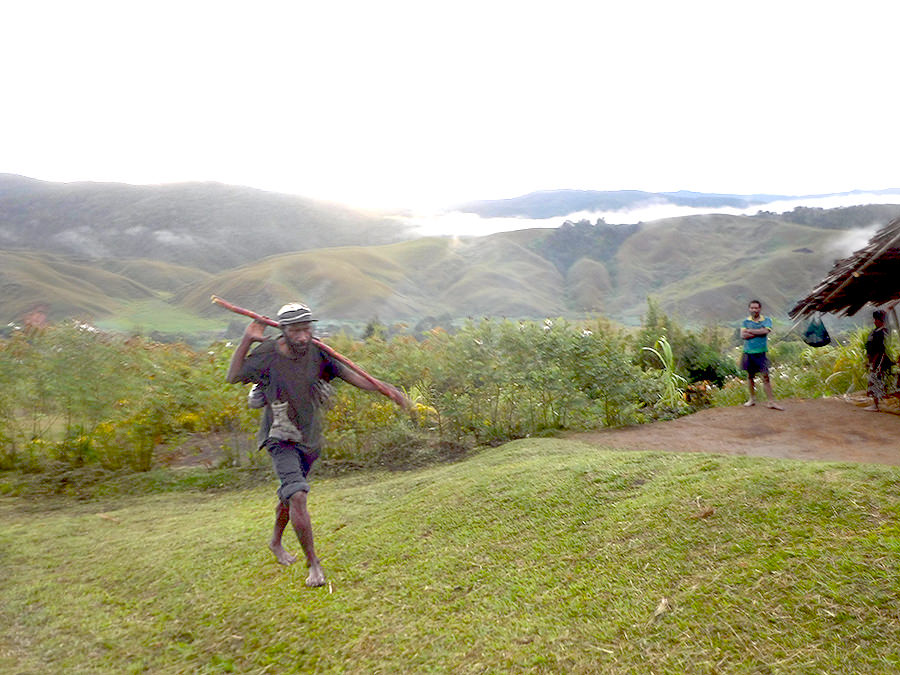
Our guide Hennis walking through the beautiful village of Kudjeru
After our coldest night spent in PNG we awoke early the next morning, after thanking our host we began what would be our final climb. The golden sun cracked the horizon, lazily casting its honeyed rays over the magnificent landscape that surrounded us. Patches of mist hung idly in the air as we made our out of primitive architecture of Kudjeru and back into the tameless jungle on the edge of the grasslands.
Hennis informed us we only had one more “bigpela” mountain to climb and then it was downhill all the way to the coast. It was all the motivation we needed, and by midday Lou and I were sat atop the peak yet again waiting for our guide to catch us up. Unfortunately we had picked a spot inhabited by a bees nest, and we were soon covered in the insects all feasting on the sweat that covered our skin. They all seemed placid enough until it came to putting our bergans back on which left Lou with several stings, and resulted in these 2 hardened explorers running down the mountain like a pair of frightened schoolgirls.
The final descent we had so looked forward to, was a slow-footed trek down an impossibly steep precipice. Any misjudgement now would have resulted in a lot more than a broken ego. Not quite the glorious jaunt we had expected it was in fact an incredibly physically and mentally demanding scramble. By the time we had reached Yanina and the start of the Bulldog track the impact on his toes had caused Louis big toenail to split and was causing him a great deal of discomfort.
As mentioned before the Buldog track was a supply line used during WW2. When the Japs had took Salamaua and Lae, the Allies needed a way to resupply the commandos fighting their way around the Wau area, and they needed it fast. The Bulldog track was one of the most incredible supply lines ever devised for any theatre of war. To construct this route, mountains were blown through and over 17 bridges built over the fast flowing Tiveri river. Over 70% of the workforce contracted Malaria, but it was finished in an incredible 8 months. The Supplies would be bought up the Lakekamu river as far as a place known as Bulldog camp, from here they would be driven along the Buldog track all the way to Eddie Creek (near Wau). It’s construction is a testament to mankind’s ability to do the impossible.
Nowadays it is nothing more of a skeleton, no bridge remains so river crossings would involve us getting wet, however from what we were used to, it was absolute luxury. If you are that way inclined there are various extreme tour companies that advertise The Bulldog track as an “extreme” trek; we didn’t see any one following it during our time on there, but it is a pretty untouched and unexploited area so definitely worth checking out.
Crossing a precariously decrepit rope bridge over an angry looking river we reached the village of Annandea. Here we spent the night in a small bush house sleeping in and amongst the family who lived there. The children of the household made sure we had our protein, and cooked alive various frogs and lizards for us to eat along with our helpings of bananas. Delicious.
The following morning when we departed it was clear Louis toenail was going to cause some problems. After only a night it was badly infected and giving him a great deal of bother. We stopped shortly after leaving, cleaned then dressed the toe before dosing him up with the strongest painkillers we had available. The boot that was causing bother was top flapped in our backpacks, and he sported a fashionable one boot one croc variant combo. To complete the look of haggard pilgrim, Hennis cut Louis a staff that would have had Moses looking on in envy. Each and every river crossing I chuckled as, stick in hand Lou would make his way across as if he were about to part the waters and lead his people to freedom.
Louis doing his best Moses impersonation, shame he couldn’t part the waters
With his foot as it was we were faced with another dilemma. The original intent was to come of the Buldog track at a crossroads then follow a bush track walking all the way to a large village called Niukeva. Here we planned to get ourselves a dugout canoe or boat to paddle our way down to the south coast. The alternative, was to follow the track all the way to the original Bulldog camp which was a much smaller settlement on the river but a great deal closer and easier to reach. In Niukeva we would certainly be able to find a vessel to take us downstream, however with Lou’s foot gradually getting worse, we opted for the gamble and made our way towards The Bulldog Camp settlement.
One of the many makeshift bridges we were forced to cross
Thankfully the gamble paid off. In the small settlement we met Simon, incredibly muscular and a lot lighter skinned than Hennis with a rhythmic voice, he was stereotypical of the people found in The Gulf Province. After being in PNG for a month, it is starting to become clear to see the various physical differences between the people of all the different regions of the country, which makes this one of the most culturally and ethnically diverse places on the planet.
Simon was a Beetelnut seller, he was in the village waiting on a supply of PNG’s drug of choice to bring down to the south coast to sell to the traders who would then take it on to Port Moresby. Fortunately for us, he had come early and had a week to wait until his supply would be ready, unfortunately however his boat wasn’t quite what we had in mind. A fairly long and wide banana boat complete with a powerful outboard on its stern. It did however come complete with 2 paddles, so human power wasn’t completely out of the question.
We sat down beneath the sago palm leave roofed building Simon had been staying in and began to outline what we required. We would like to use his boat for the 2 days it would take us to travel the 70km downstream to the south coast of PNG, ideally we would like him to remove the outboard and let us paddle all the way. We explained the premise of our challenge to him, and he found the idea of 2 white men paying to paddle a group of PNG citizens utterly wonderful. There was however one area of what we proposed he would not shift on, the outboard would stay on.
“This is not England. This is not Australia. This is PNG and the danger here is real”
He said to us, all levity gone from our discussion. The Lakekamu river has pirates that had targeted Simon in the past. One such encounter had him facing down the barrels of an armed gang of 6 balaclava clad young men, with one of his passengers being hacked near to death when he voiced his complaints to being robbed for all he had. As dated as the concept may seem our white skin has had its benefits in PNG, however it is also an advert for our relative wealth and Simon was very clear in the danger we presented him in pursuing this trip down the river.
We finally agreed on a price to “rent” his boat, on the proviso that he would be taking the helm if there was any sign of “River Raskols”. That evening we lanced, drained, cleaned and re-dressed Louis now heavily infected toe, despite my insistence, he wouldn’t let me spray the affected area with iodine, but aside from that he was an exceptionally brave little soldier.
We awoke before first light to set out on our penultimate days journey, It was Louis 28th birthday and had got his wish to be finished “yomping” by his special day, just in time considering the state of his toe. Hennis had stayed along “for the ride” and Simon had bought his 2 young sons, his brother, and some old chap who no-one really knew exactly where he had come from, so the boat was pretty full as we paddled out into the morning mist.
Almost at sea level the heat, humidity, and mosquitos had returned from the respite we had received at altitude, and they all were relentless in their onslaught on us. As the day evolved we slowly stewed and sweated our bodies used to the relative cool offered during our past week spent above 2000m.
The murky brown waters of the Lakekamu swiftly snaked their way through the Gulf province. Hornbills, birds of paradise and cockatiels soared between the towering lush trees that cascaded over our course, filling the air with their crisp melodic songs whilst bare chested fishermen in dugout canoes sliced their way through the river with their ornately carved wooden paddles.
On more than one occasion, on hearing an exceptionally loud approaching outboard Simon would silently direct us into the thick green undergrowth that lined the banks of the river. He we would sit breath held, waiting for the boat pass. Our skipper was taking no chances with his precious cargo. Aside from these few instances, our passage was a relaxed welcome relief, to the battering our bodies were used to. Simons 2 young sons, spent the entire voyage singing traditional songs of The Gulf Province, their faultless voices a fitting accompaniment given the scene we were making our way through.
As the sun passed its zenith and languidly made its way down towards the horizon we reached Simons home village of Terapo Bridge. The settlement sits on the banks of the Lakekamu river and next to the highway that links the town of Kerema with the capital Port Moresby. A full days paddling had bought us here only 12km from PNG’s south coast. The end was in sight. Simons wife, set to cooking us a feast on hearing our tales of adventure, and curious residents from around the settlement flocked to us like moths to a flame, all intent on hearing our “stories”. The lads certainly can “spin a dit”.
Simon and his family warned us not to go walking around the village, the previous day 6 Raskols had held up the local canteen store 3 doors down from his house. As they fled with their ill-gotten gains, The Chinese owner of the shop had thrown a tin of tuna at the head of the last thief. Reminisce of something out of a Jackie Chan movie, the tuna had found its mark and knocked unconscious the last of the gang. It did not end well for him. The mob rules in PNG, suffice to say by the time the police arrived, all that was left was a mutilated corpse, cut to shreds by the locals stirred into a frenzy by the attack on their village. It was another vivid reality check for us both, and we took the opportunity to get an early night.
Louis having 40 winks on our Voyage down the dangerous LakeKamu river
The following morning, we awoke early again. After hearing our tales, most of the village seemed to want to accompany us for the end of our epic journey. We left with a boat full to bursting with people, all laughing, smiling and joking as we paddled south. We were even graced with the presence of one of the local police force who had specially polished his boots for the occasion. It was however, slightly surreal having him sat between Hennis and Simon, who between them seemed to be trying to outdo Bob Marley in their smoking habits.
After 2 and half hours we reached the settlement of Lalafifi situated right on the mouth of the Lakekamu river. There was no huge tidal delta, the river simply entered the sea with little fuss or turbulence. Simon indicated an area next to the village where the legless torso of a man had been found a couple of months previous, one of many victims of the huge salt water crocodile population in the province. As many of you have already seen once here, we used the opportunity to record a short finishing video on Louis mobile. Needless to say, I did not stay long after diving in the water. Pretty stupid, but extreme measures are sometimes needed when trying to get people to part with their hard-earned cash!
North to South of PNG in the bag! 695km, around 200km on highways, 400km through jungles and over mountains, and 95 paddling down the Lakekamu. We came ashore in Lalafifi and were given freshly cooked fish and coconuts by the locals who were in awe at the journey we had just accomplished. Boarding Simons banana boat, we both grinned at each other as he fired his outboard up, and made our journey back to Terapo in mere minutes.
Papua New Guinea in the bag!!
Despite our human powered journey being over, we could not relax just yet. We still had to get to the capital, and find somewhere to stay to book our flights home. Back in Terapo, Simon and entourage took us to where the PMV’s would be passing on their way to Port Moresby. Hennis who had family in the city said he would accompany us so he could visit his relatives. We sat for 2 hours being drove past by every PMV which were all dangerously overcrowded. Eventually one passed and stopped, on inspection Simon warned us not to go on this specific vehicle. It was fully loaded with bags and bags of beetelnut, the truck we were told would be going through the settlements selling the nut and would not finish its journey until every bag was sold. Looking at the otherwise deserted road we agreed we would take our chances and boarded.
It was a large pickup equipped with a canvas roof, onboard as well as the beetelnut was around 40 people all red toothed chewing on their wares, it was hot, cramped and uncomfortable. The 300km journey should of took between 3-6hours, despite our driver who could of given Lewis Hamilton a run for his money it took 12. Stopping at the larger settlements, the owner of the PMV and the seller of the beetelnut would leave the vehicle and go and discuss with parked convoys of vehicles to reach a price for his product. On one such stop we left the vehicle and asked to film what was going on, the buyers and seller smiled gleefully and discussed in detail the amount of money they were making on the nations addiction. The PMV owner, a huge man with hair reminisce of a pineapple, pulled from his pocket a bag full of 50kina notes, he smiled a maroon smile and said;
“PNG gold boys”
Chatting to the “muscle” for one of the buyers, we were informed that he alone makes 1200kina a day (£300) purely for security, so it gives an idea what the buyers and sellers are earning. There is nowhere in PNG we have been where we haven’t seen all the adults constantly chewing beetelnut, overuse causes a form of psychosis, loss of teeth and mouth cancer. From an outsiders perspective it appears the whole nation is heavily addicted, having tried it, we both are puzzled by the attraction it seems to have, it tastes bad and makes you spit lots all for a relatively mild head rush.
The Mad Explorers
As the day slipped away we grew more and more frustrated at our choice of transport, we would sit for hours in each location, we began to get concerned we would reach Moresby far too late to find accommodation. Our worries were laid at ease when I received a text message from our pal Wayne saying;
“I’ve taken the liberty to book you 2 into the Gateway hotel by the airport in POM”
Liberty taking legend. At around 11pm we reached the outskirts of Port Moresby, with still a few bags of beetelnut remaining the PMV made its way into a rundown district. The air was thick with pungent acrid black smoke from tyres burning in the centre of the road. Dozens of young men lined the streets, all holding a wide array of knifes and weapons, they were all drinking, shouting and some fighting amongst each other. Music from a stereo pumped loudly, as the PMV drew to a stop Hennis, who knew the districts around Moresby well, drew Louis and me close and said urgently;
“Hide your faces. Do not leave the truck”
Leaning forward we did our best to shield our white skin from the view of the gang outside who were taking it in turns to leer inside the back of the PMV at the remaining beetelnut on display. Luckily for us we were positioned towards the front of the wagon and many of the passengers who we had developed a rapport with during our journey helped to shield us from sight.
After what seemed a lifetime, the last of the nut was offloaded and we drove out of the dilapidated project.
Finally, we reached Moresby, and were taken to the security of the gated hotel compound Wayne had booked us into. Our flights were booked, and we spent the following day eating our own weight in junk food.
Our journey across The Land of The Unexpected has proven a real revelation for us both. It is an adventurer’s mecca and a place that I hope to return to one day. Despite the constant danger posed to us, we were shown nothing but kindness and generosity by a people who literally have nothing but the coconuts and bananas in their gardens. The understanding shown towards the challenge we have set out on, and our motivation behind it truly blew us away. The fact the people we met displayed admiration and solidarity towards a cause so far away from their daily struggles was genuinely profound.
The government out here gives the people here nothing, yet taxes are sky high. These are a people that scrape together every penny they have, walk barefoot for days and nights through mountainous jungle to buy materials so that they can carry them back to their villages and build their children a school, so that their offspring can have the chance of an education. Though the nation has a lot of growing to do, there is a lot people back in the west can learn from these wonderful men and women.
With 2 island, down we both would like to thank each and everybody who has been following and supporting our challenge. When I first met Louis after we both returned from Afghanistan he was really struggling. It is a testament to his character that he has battled the demons he faced head on. This is a major reason we are both trying to raise as much funds as we can for Help for Heroes and The Royal Marines Charity; Both these organisations do a great deal to help drastically improve the lives of servicemen and women. It is a tragedy that such organisations need to exist, however they do, and the work they do is beyond commendable.
The likes we receive on our pictures and videos are great, however likes unfortunately don’t change lives. Money does.
If you really have been inspired by the insane challenge we both have put our lives on hold to pursue #chuckusafiver via the link below.
Anthony Lambert
Co-founder Expedition5
anthony.lambert@expeditionfive.co.uk
www.expeditionfive.co.uk
